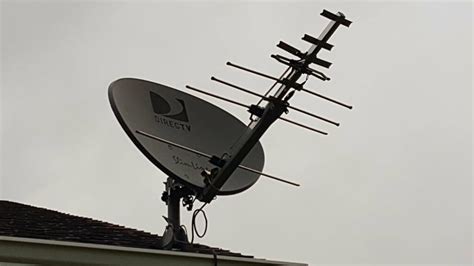Types of DTV Antennas
DTV antennas can be categorized into several types based on their design, installation location, and reception capabilities.
Indoor Antennas
Indoor antennas are designed for use inside your home and are generally smaller and more discreet than outdoor antennas. They are easy to set up and can be placed near your television or in a window for better reception.
-
Flat Antennas: These thin, rectangular antennas are often called “mud flap” antennas due to their shape. They are designed to be mounted on a wall or placed flat on a surface.
-
Dipole Antennas: Also known as “rabbit ears,” these antennas consist of two telescoping metal rods that can be adjusted for optimal reception.
-
Loop Antennas: These antennas are circular or rectangular and are designed to pick up UHF signals. They can be placed on a tabletop or mounted on a wall.
Outdoor Antennas
Outdoor antennas are installed outside your home, typically on your roof or in your attic. They are larger and more powerful than indoor antennas and can receive signals from farther away.
-
Yagi Antennas: These antennas have a long, horizontal boom with multiple crossbars called elements. They are directional, meaning they need to be pointed towards the broadcast tower for the best reception.
-
Multi-directional Antennas: These antennas, such as the popular “bowtie” design, can receive signals from multiple directions without the need for precise aiming.
-
Omnidirectional Antennas: These antennas can receive signals from all directions equally. They are ideal for areas with broadcast towers located in different directions.
| Antenna Type | Advantages | Disadvantages |
|---|---|---|
| Indoor | Easy to install, discreet | Limited range, prone to interference |
| Outdoor | Longer range, better reception | Requires installation, more visible |
Antenna Installation
Installing a DTV antenna can be a straightforward process, but it is important to follow the manufacturer’s instructions and take proper safety precautions.
Indoor Antenna Installation
- Choose a location for your antenna, such as near a window or on a wall facing the broadcast tower.
- Connect the antenna to your television’s “ANT IN” port using a coaxial cable.
- Scan for available channels using your TV’s built-in tuner.
- Adjust the antenna’s position for the best reception.
Outdoor Antenna Installation
- Determine the best location for your antenna, such as on your roof or in your attic.
- Assemble the antenna according to the manufacturer’s instructions.
- Mount the antenna securely using the provided hardware.
- Run a coaxial cable from the antenna to your television, using a grounded lightning arrestor for safety.
- Connect the coaxial cable to your TV’s “ANT IN” port and scan for available channels.
DIY DTV Antenna
If you are feeling handy, you can make your own DTV antenna using readily available materials. Here’s a simple guide to making a “bowtie” antenna:
Materials Needed
- 8 wire coat hangers
- Pliers
- Screwdriver
- Matching transformer (300 to 75 ohms)
- Coaxial cable
- Wire cutters
Steps
- Straighten out the coat hangers and cut them into 8 equal lengths of about 16 inches each.
- Arrange the wires into a bowtie shape, with the center points crossing each other.
- Twist the center points together tightly using pliers.
- Attach the matching transformer to the center of the bowtie using the screwdriver.
- Connect one end of the coaxial cable to the matching transformer and the other end to your TV’s “ANT IN” port.
- Hang the antenna in a window or on a wall, and scan for available channels.

FAQ
-
Q: What is the difference between UHF and VHF antennas?
A: UHF (Ultra High Frequency) antennas are designed to receive channels 14-51, while VHF (Very High Frequency) antennas receive channels 2-13. Most modern DTV antennas are designed to receive both UHF and VHF signals. -
Q: Can I use an outdoor antenna indoors?
A: While it is possible to use an outdoor antenna indoors, it may not be practical due to its size and the need for proper grounding. Indoor antennas are specifically designed for use inside your home and are generally easier to install. -
Q: How do I know which direction to point my antenna?
A: You can use online resources such as AntennaWeb or the FCC’s DTV Reception Maps to determine the location of broadcast towers in your area. Point your antenna towards the nearest tower for the best reception. -
Q: Can I use a splitter to connect multiple TVs to one antenna?
A: Yes, you can use a splitter to connect multiple TVs to a single antenna. However, keep in mind that splitting the signal may result in weaker reception on each connected TV. -
Q: Do I need an amplifier for my antenna?
A: If you live far from broadcast towers or have a long cable run, an amplifier can help boost the signal strength. However, if you live close to towers or have a strong signal, an amplifier may not be necessary and could even cause reception issues.
In conclusion, DTV antennas provide a reliable and cost-effective way to receive high-quality digital broadcast signals. By understanding the different types of antennas, their installation process, and even the possibility of making your own, you can ensure that you have the best possible reception for your favorite shows and channels.






Leave a Reply